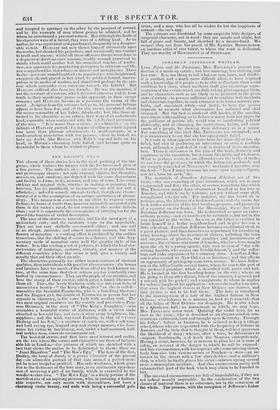THE GOSSIP'S WEL
Tns: charm of these stories lies in the vivid painting of the lan- guage, which realizes the images wiih the freshness and glow of a fine picture. The author's ideas are evolved in palpable firms and picturesque shapes : not only external objects, but thoughts, sensations, and emotions, are depicted with the same distinctness and facility as forms, looks, manner, and tone of voice. Like every striking and original style, whether in writing or painting, this, however, has its peculiatity or mannerism—we will not call it affectation: indeed it scarcely amounts to that, though one charac- teristic of it is the assumption of an antique quaintness of phrase- ology. This mannerism consists in an ell;irt to express vague feelings by forms of words that, however intimately associated with them in the writer's mind, do not convey to the reader definite ideas; and it is apparently the consequence of carrying too !Sr the pencil-like touches of verbal description.
The tone of the stories is romantic, and for the most part of a melancholy east; and the incidents verge on the improbable. They are not very skilfully constructed either; and are told in an abrupt, intricate, and almost inverted manner, but with fluency of narration : a startling effect is produced by the sudden transitions, like the shilling of scenes in a drama ; and this frag- mentary mode of narration suits well the graphic style of the writer. It is like reading a set of pictures, to attic!, the local cha- racteristics of landscape, costume, climate, and manner of the different countries where the scene is laid, give a variety and novelty that aid their effect greatly.
The characters generally are rather impersonations of abstract qualities, than individuals with peculiar idiosyncracies : the heroes and heroines have too much of the bean ?Will for frail human na- ture, at the same time that their actions are too constantly con- trolled by circumstances. They are the people of one creation, and bear the stamp of their creator, which gives a family likeness to them all. Thus, the lovely Galena, with Inc innocent looks of unconscious beauty—" the King's Daughter " as she is called— resembles the beautiful Fiammetta, who is a foundling likewise; and the Zingat a gill, the double of Fiammetta in person but her opposite in character, is the same body with another soul. The two most original escalates are the courtly and passionless Prin- cess Herminia, in the story of " The King's Daughter,"--who resembles a beautiful statue of alabaster, with a sweet smile chiselled on her cold lips, and eyes of clear stony brightness, like sapphires; and the wild, wayward Isabella, in that of " Count Dalberg and his Son,"—a creature of contrasts, with a soft voice and bold roving eye, languid step and abrupt manner, who fasci- nates her victim by tantalizing, and, under a half-assumed, half- real reekles-mess, conceals consummate art.
The best-told stories, and that have most interest and reality, are the two where the scenes and characters are those of fashion- able life in London,—tire picture's of which are sketched with a tact that shows the author to be habituated to them : these are
"Janet Hamilton" and "The Roe's Egg." The hero of the first, Dudley, the lover of Janet, is a preux crieralier of the present day—an admirable portrait of that rare animal a perfect man; yet he is not insipid or artificial. Ills only weakness, which gives
rise to the distresses of the love story, is an aristocratic apprehen- sion of marrying a girl of no family, which is overruled by the
wonder-worker love. " The Rae's Egg" is a lively picture of the modifications of an aspiring parvenu, who, in pursuing a fashion- able coquette, not only meets with discomfiture, but loses a charming rustic beauty, and ends with being a successful poli- tician, and a man who has all he wishes for but the happiness of content—the roe's egg.
The volumes are illustrated by some exquisite little designs, of congenial character, cut in wood: they are simple and slight, but full of grace and beauty, and sketched by a master-hand. We suspect they are from the pencil of Mr. SAMUEL BOODINGTON. an amateur artist of rare talent, to whom the work is dedicated, They are worthy of BONI NGTON or of STOTHAR D.


























 Previous page
Previous page